Advances in Flame-Retardant Coatings for Rigid Polyurethane Foams: A Critical Review
Abstract
1. Introduction
2. Fame Retardancy of RPUF
2.1. Flame-Retardant Mechanism
2.2. Additive Flame Retardant
2.3. Reactive Flame Retardant
2.4. Flame Retardant Coating
3. The Design Principles and Evolution of Flame-Retardant Coating
3.1. Intumescent Coating
3.2. Non-Intumescent Inorganic/Organic Coating
3.2.1. Aerogel Coating
3.2.2. Hydrogel Coating
3.2.3. Other Hybrid Coatings
3.3. Bio-Inspired Flame-Retardant Coating
4. Synthesis and Processing: From Laboratory Innovation to Industrial Scalability
4.1. LbL Assembly and Dip-Coating Techniques
4.2. Spray Coating
4.3. UV-Curing Coating
4.4. Brush Coating
4.5. Spin Coating
5. Concluding Remarks and Future Aspects
Author Contributions
Funding
Data Availability Statement
Conflicts of Interest
References
- Fu, Y.; Qiu, C.; Ni, L.; Ye, H.; Zou, H.; Luo, Y.; Liang, M. Cell structure control and performance of rigid polyurethane foam with lightweight, good mechanical, thermal insulation and sound insulation. Constr. Build. Mater. 2024, 447, 138068. [Google Scholar] [CrossRef]
- Haridevan, H.; Evans, D.A.; Ragauskas, A.J.; Martin, D.J.; Annamalai, P.K. Valorisation of technical lignin in rigid polyurethane foam: A critical evaluation on trends, guidelines and future perspectives. Green. Chem. 2021, 23, 8725–8753. [Google Scholar] [CrossRef]
- Iqbal, N.; Mubashar, A.; Ahmed, S.; Arif, N.; Din, E.-U. Investigating relative density effects on quasi-static response of high-density Rigid Polyurethane Foam (RPUF). Mater. Today Commun. 2022, 31, 103320. [Google Scholar] [CrossRef]
- Ma, Z.; Zhang, J.; Liu, L.; Zheng, H.; Dai, J.; Tang, L.-C.; Song, P. A highly fire-retardant rigid polyurethane foam capable of fire-warning. Compos. Commun. 2022, 29, 101046. [Google Scholar] [CrossRef]
- Kim, H.J.; Jin, X.; Choi, J.W. Investigation of bio-based rigid polyurethane foams synthesized with lignin and castor oil. Sci. Rep. 2024, 14, 13490. [Google Scholar] [CrossRef]
- Ma, C.; Qiu, S.; Xiao, Y.; Zhang, K.; Zheng, Y.; Xing, W.; Hu, Y. Fabrication of fire safe rigid polyurethane foam with reduced release of CO and NOx and excellent physical properties by combining phosphine oxide-containing hyperbranched polyol and expandable graphite. Chem. Eng. J. 2022, 431, 133347. [Google Scholar] [CrossRef]
- Zhang, X.; Wang, Z.; Ding, S.; Wang, Z.; Xie, X. Improved thermal insulation, mechanical properties, energy absorption and flame retardancy of bio-based rigid polyurethane foam modified with calcium hydroxystannate. Constr. Build. Mater. 2024, 456, 139251. [Google Scholar] [CrossRef]
- Andersons, J.; Grūbe, R.; Vēvere, L.; Cābulis, P.; Kirpluks, M. Anisotropic thermal expansion of bio-based rigid low-density closed-cell polyurethane foams. J. Mater. Res. Technol. 2022, 16, 1517–1525. [Google Scholar] [CrossRef]
- Prociak, A.; Kucała, M.; Kurańska, M.; Barczewski, M. Effect of selected bio-components on the cell structure and properties of rigid polyurethane foams. Polymers 2023, 15, 3660. [Google Scholar] [CrossRef] [PubMed]
- Li, C.; Ma, H.; Song, C.; Zhou, Z.; Xu, W.; Song, Q.; Ren, F. Preparation and performance of melamine-formaldehyde rigid foams with high closed cell content. Cell. Polym. 2021, 40, 183–197. [Google Scholar] [CrossRef]
- Alsuhaibani, A.M.; Refat, M.S.; Qaisrani, S.A.; Jamil, F.; Abbas, Z.; Zehra, A.; Baluch, K.; Kim, J.-G.; Mubeen, M. Green buildings model: Impact of rigid polyurethane foam on indoor environment and sustainable development in energy sector. Heliyon 2023, 9, e14451. [Google Scholar] [CrossRef]
- Barszczewska-Rybarek, I.; Jaszcz, K.; Chladek, G.; Grabowska, P.; Okseniuk, A.; Szpot, M.; Zawadzka, M.; Sokołowska, A.; Tarkiewicz, A. Characterization of changes in structural, physicochemical and mechanical properties of rigid polyurethane building insulation after thermal aging in air and seawater. Polym. Bull. 2022, 79, 3061–3083. [Google Scholar] [CrossRef]
- Yuan, Y.; Yu, B.; Shi, Y.; Ma, C.; Song, L.; Hu, W.; Hu, Y. Highly efficient catalysts for reducing toxic gases generation change with temperature of rigid polyurethane foam nanocomposites: A comparative investigation. Compos. Part A Appl. Sci. Manuf. 2018, 112, 142–154. [Google Scholar] [CrossRef]
- Yuan, Y.; Wang, W.; Shi, Y.; Song, L.; Ma, C.; Hu, Y. The influence of highly dispersed Cu2O-anchored MoS2 hybrids on reducing smoke toxicity and fire hazards for rigid polyurethane foam. J. Hazard. Mater. 2020, 382, 121028. [Google Scholar] [CrossRef] [PubMed]
- Tian, F.; Wu, Y.; Xu, H.; Wang, B.; She, Y.; Chen, H.; Liu, Y.; Wang, S.; Xu, X. Enhancing Rigid Polyurethane Foam Properties with Lignin-Based Core–Shell Intumescent Flame Retardants. ACS Sustain. Chem. Eng. 2024, 12, 18126–18135. [Google Scholar] [CrossRef]
- Bu, F.-Y.; Fu, Z.-C.; Dong, Q.-X.; Wang, T.; An, W.-L.; Deng, J.-N.; Deng, C.; Yan, Y.-W.; Chen, M.-J. Flame-Retardant and Mechanical Strong Polyurethane Foam Enabled by Hydrogen-Bonded Phosphonate Networks. ACS Appl. Polym. Mater. 2025, 7, 8186–8198. [Google Scholar] [CrossRef]
- Zheng, L.; Zhan, J.; Wang, J.; Xu, Z.; Mu, X. Highly efficient flame retardancy and fire spread behavior of rigid polyurethane foams with extremely low content of flame retardant. Polym. Degrad. Stab. 2024, 230, 111039. [Google Scholar] [CrossRef]
- Muhammed Raji, A.; Hambali, H.U.; Khan, Z.I.; Binti Mohamad, Z.; Azman, H.; Ogabi, R. Emerging trends in flame retardancy of rigid polyurethane foam and its composites: A review. J. Cell. Plast. 2023, 59, 65–122. [Google Scholar] [CrossRef]
- Lee, S.H.; Lee, S.G.; Lee, J.S.; Ma, B.C. Understanding the flame retardant mechanism of intumescent flame retardant on improving the fire safety of rigid polyurethane foam. Polymers 2022, 14, 4904. [Google Scholar] [CrossRef]
- Wang, Z.; Liu, N.; Yuan, H.; Chen, H.; Xie, X.; Zhang, L.; Rein, G. Smouldering and its transition to flaming combustion of polyurethane foam: An experimental study. Fuel 2022, 309, 122249. [Google Scholar] [CrossRef]
- Yuan, Y.; Wang, W.; Xiao, Y.; Yuen, A.C.Y.; Mao, L.; Pan, H.; Yu, B.; Hu, Y. Surface modification of multi-scale cuprous oxide with tunable catalytic activity towards toxic fumes and smoke suppression of rigid polyurethane foam. Appl. Surf. Sci. 2021, 556, 149792. [Google Scholar] [CrossRef]
- Tang, G.; Guan, M.; Yang, S.; Fang, Y.; Liu, X.; Dai, K.; Wang, W. Highly thermally stable MOF-based flame retardant system for fire-safe and toxicity-suppressing rigid polyurethane foam. Constr. Build. Mater. 2025, 477, 141382. [Google Scholar] [CrossRef]
- Lee, T.; Kim, J.-H.; Tsang, Y.F.; Chen, W.-H.; Lee, D.; Jung, M.-W.; Jung, S.; Kwon, E.E. Conversion of toxic chemicals into flammable gases through the thermolysis of polyurethane foam using CO2. Chem. Eng. J. 2023, 457, 141291. [Google Scholar] [CrossRef]
- Qu, J.; Tong, Y.; Bi, Y.; Sun, W.; Shi, Y.; Zhao, Z.; Liu, Z.; Wang, S.; Liu, L.; Chen, X. P-N hybrids modified with MXene encapsulation significantly improve fire safety properties of rigid polyurethane foams. Polym. Degrad. Stab. 2025, 241, 111590. [Google Scholar] [CrossRef]
- Huang, X.; Wang, C.; Gao, J.; Zhou, Z.; Tang, G.; Wang, C. Research on two sides horizontal flame spread over rigid polyurethane with different flame retardants. J. Therm. Anal. Calorim. 2021, 146, 2141–2150. [Google Scholar] [CrossRef]
- Yang, Y.; Shen, H.; Luo, Y.; Zhang, R.; Sun, J.; Liu, X.; Zong, Z.; Tang, G. Rigid polyurethane foam composites based on iron tailing: Thermal stability, flame retardancy and fire toxicity. Cell. Polym. 2022, 41, 189–207. [Google Scholar] [CrossRef]
- Lu, D.; Wang, Y. Mesoporous Heat-Trapping and Smoke-Adsorbing Fe-MOFs Improve Fire Safety and Compression Resistance of Rigid Polyurethane Foam. Langmuir 2025, 41, 24995–25014. [Google Scholar] [CrossRef]
- Bo, G.; Xu, X.; Tian, X.; Yan, J.; Su, X.; Yan, Y. Bio-based rigid polyurethane foams modified with C-MOF/MWCNTs and TBPBP as building insulation materials: Synergistic effect and corresponding mechanism for enhancing fire and smoke safety. Polymers 2022, 14, 3630. [Google Scholar] [CrossRef]
- Chen, Z.; Yuan, S.; Xu, X. Synergistic Effect of Amino-Modified Co-MOF and APP on Improvement of the Fire Safety of the Rigid Polyurethane Foam. ACS Omega 2024, 10, 892–903. [Google Scholar] [CrossRef]
- Luo, W.; Wang, T.; Gou, X.; Luo, J.; An, W.; Fu, Z.-C.; Deng, J.; Zhao, H.-B.; Chen, M.-J. In Situ Assembly of Nanostructured Polyelectrolyte Coatings by Aqueous Phase Separation toward Outstanding Thermal Insulation and Fire Resistance. ACS Mater. Lett. 2024, 6, 5418–5428. [Google Scholar] [CrossRef]
- Zhu, H.; Xu, S.-A. Preparation and fire behavior of rigid polyurethane foams synthesized from modified urea–melamine–formaldehyde resins. RSC Adv. 2018, 8, 17879–17887. [Google Scholar] [CrossRef]
- Yuan, Y.; Lin, W.; Xiao, Y.; Yu, B.; Wang, W. Advancements in flame-retardant systems for rigid polyurethane foam. Molecules 2023, 28, 7549. [Google Scholar] [CrossRef] [PubMed]
- Kondaveeti, S.; Patel, P.; de Souza, F.M.; Gupta, R.K. Exploring soybean oil-based polyol and the effect of non-halogenated flame retardants in rigid polyurethane foam. J. Polym. Environ. 2024, 32, 5873–5887. [Google Scholar] [CrossRef]
- Cui, Z.; Han, J.; Sun, J.; Chen, Y.; Wang, X.; Gu, X.; Zhang, S. Preparation of aliphatic bio-based polyester polyols for water-blown and halogen-free flame retardant rigid polyurethane foam. Polym. Degrad. Stab. 2024, 226, 110832. [Google Scholar] [CrossRef]
- Yuan, Y.; Yang, H.; Yu, B.; Shi, Y.; Wang, W.; Song, L.; Hu, Y.; Zhang, Y. Phosphorus and nitrogen-containing polyols: Synergistic effect on the thermal property and flame retardancy of rigid polyurethane foam composites. Ind. Eng. Chem. Res. 2016, 55, 10813–10822. [Google Scholar] [CrossRef]
- Son, T.; Nguyen, H.T.; Phan, H.T.; Pham, C.T.; Nguyen, B.T.; Pham, L.H.; Do, T.V.V.; Vothi, H.; Kim, J.; Hoang, D.Q. Phosphorus/phosphorus-nitrogen flame retardants applied to polyurethane/rice husk eco-composites: Thermal behavior, flame retardancy, and physico-mechanical properties. Polym. Bull. 2021, 78, 2727–2743. [Google Scholar] [CrossRef]
- Lu, W.; Li, Q.; Zhang, Y.; Yu, H.; Hirose, S.; Hatakeyama, H.; Matsumoto, Y.; Jin, Z. Lignosulfonate/APP IFR and its flame retardancy in lignosulfonate-based rigid polyurethane foams. J. Wood Sci. 2018, 64, 287–293. [Google Scholar] [CrossRef]
- Luo, F.; Wu, K.; Li, Y.; Zheng, J.; Guo, H.; Lu, M. Reactive flame retardant with core-shell structure and its flame retardancy in rigid polyurethane foam. J. Appl. Polym. Sci. 2015, 132. [Google Scholar] [CrossRef]
- Shi, L.; Li, Z.M.; Xie, B.H.; Wang, J.H.; Tian, C.R.; Yang, M.B. Flame retardancy of different-sized expandable graphite particles for high-density rigid polyurethane foams. Polym. Int. 2006, 55, 862–871. [Google Scholar] [CrossRef]
- Acuña, P.; Li, Z.; Santiago-Calvo, M.; Villafañe, F.; Rodríguez-Perez, M.Á.; Wang, D.-Y. Influence of the characteristics of expandable graphite on the morphology, thermal properties, fire behaviour and compression performance of a rigid polyurethane foam. Polymers 2019, 11, 168. [Google Scholar] [CrossRef]
- Acuña, P.; Santiago-Calvo, M.; Villafañe, F.; Rodríguez-Perez, M.A.; Rosas, J.; Wang, D.Y. Impact of expandable graphite on flame retardancy and mechanical properties of rigid polyurethane foam. Polym. Compos. 2019, 40, E1705–E1715. [Google Scholar] [CrossRef]
- Qian, X.; Liu, Q.; Zhang, L.; Li, H.; Liu, J.; Yan, S. Synthesis of reactive DOPO-based flame retardant and its application in rigid polyisocyanurate-polyurethane foam. Polym. Degrad. Stab. 2022, 197, 109852. [Google Scholar] [CrossRef]
- Zhan, Z.; Shi, Q.; Shen, J.; Bao, T.; Weng, S.; Li, L.; Meng, F. Novel multifunctional DOPO-containing polyaniline for highly efficient flame retardance and static electricity control for rigid polyurethane foam. Compos. Commun. 2024, 48, 101951. [Google Scholar] [CrossRef]
- Tang, G.; Zhang, Z.; Wang, R.; Xu, Z.; Guan, M.; Deng, D.; Wu, S.; Dai, K.; Liu, X. Improvements in the flame retardancy, smoke suppression, mechanical strength and thermal insulating properties of rigid polyurethane foams modified with DOPO-grafted cyclosiloxane and diatomite. Constr. Build. Mater. 2025, 495, 143620. [Google Scholar] [CrossRef]
- Zhu, H.; Xu, S. Preparation of flame-retardant rigid polyurethane foams by combining modified melamine-formaldehyde resin and phosphorus flame retardants. ACS Omega 2020, 5, 9658–9667. [Google Scholar] [CrossRef] [PubMed]
- Jia, D.; Yang, J.; He, J.; Li, X.; Yang, R. Melamine-based polyol containing phosphonate and alkynyl groups and its application in rigid polyurethane foam. J. Mater. Sci. 2021, 56, 870–885. [Google Scholar] [CrossRef]
- Liu, M.; Gong, Z.; Wang, G.; Liu, X.; Hou, Y.; Tang, G. Melamine resin coordinated cobalt@ piperazine pyrophosphate microcapsule: An innovative strategy for imparting long-lasting fire safety to rigid polyurethane foams. Polym. Degrad. Stab. 2024, 219, 110605. [Google Scholar] [CrossRef]
- Yin, S.; Du, Y.; Liang, X.; Xie, Y.; Xie, D.; Mei, Y. Surface coating of biomass-modified black phosphorus enhances flame retardancy of rigid polyurethane foam and its synergistic mechanism. Appl. Surf. Sci. 2023, 637, 157961. [Google Scholar] [CrossRef]
- Huang, Y.; Jiang, S.; Liang, R.; Liao, Z.; You, G. A green highly-effective surface flame-retardant strategy for rigid polyurethane foam: Transforming UV-cured coating into intumescent self-extinguishing layer. Compos. Part A Appl. Sci. Manuf. 2019, 125, 105534. [Google Scholar] [CrossRef]
- Liu, H.; Yang, H.; Chen, M.; Jiang, Y.; Wan, C. An effective approach to reducing fire hazards of rigid polyurethane foam: Fire protective coating. J. Coat. Technol. Res. 2019, 16, 257–261. [Google Scholar] [CrossRef]
- Fang, Y.; Ma, Z.; Wei, D.; Yu, Y.; Liu, L.; Shi, Y.; Gao, J.; Tang, L.C.; Huang, G.; Song, P. Engineering sulfur-containing polymeric fire--retardant coatings for fire-safe rigid polyurethane foam. Macromol. Rapid Commun. 2024, 45, 2400068. [Google Scholar] [CrossRef]
- Yang, Y.; Dang, B.; Wang, C.; Chen, Y.; Chen, K.; Chen, X.; Li, Y.; Sun, Q. Ultrastrong lightweight nanocellulose-based composite aerogels with robust superhydrophobicity and durable thermal insulation under extremely environment. Carbohydr. Polym. 2024, 323, 121392. [Google Scholar] [CrossRef]
- Zhang, K.; Li, C.; Liu, L.; Wang, X.; Li, N.; Yang, C.; Huang, Y.; Lu, H.; Liu, H.; Li, J. Developing lightweight silanized cellulose ultramaterials as the strongest engineered aerogel. Adv. Funct. Mater. 2025, 35, 2415963. [Google Scholar] [CrossRef]
- Guo, W.; Chen, S.; Liang, F.; Jin, L.; Ji, C.; Zhang, P.; Fei, B. Ultra-light-weight, anti-flammable and water-proof cellulosic aerogels for thermal insulation applications. Int. J. Biol. Macromol. 2023, 246, 125343. [Google Scholar] [CrossRef]
- Gu, J.; Fu, R.; Kang, S.; Yang, X.; Song, Q.; Miao, C.; Ma, M.; Wang, Y.; Sai, H. Robust composite aerogel beads with pomegranate-like structure for water-based thermal insulation coating. Constr. Build. Mater. 2022, 341, 127722. [Google Scholar] [CrossRef]
- Ciecierska, E.; Jurczyk-Kowalska, M.; Bazarnik, P.; Gloc, M.; Kulesza, M.; Kowalski, M.; Krauze, S.; Lewandowska, M. Flammability, mechanical properties and structure of rigid polyurethane foams with different types of carbon reinforcing materials. Compos. Struct. 2016, 140, 67–76. [Google Scholar] [CrossRef]
- Xu, W.; Wang, G.; Zheng, X. Research on highly flame-retardant rigid PU foams by combination of nanostructured additives and phosphorus flame retardants. Polym. Degrad. Stab. 2015, 111, 142–150. [Google Scholar] [CrossRef]
- Thirumal, M.; Khastgir, D.; Singha, N.K.; Manjunath, B.; Naik, Y. Effect of expandable graphite on the properties of intumescent flame-retardant polyurethane foam. J. Appl. Polym. Sci. 2008, 110, 2586–2594. [Google Scholar] [CrossRef]
- Strąkowska, A.; Członka, S.; Konca, P.; Strzelec, K. New flame retardant systems based on expanded graphite for rigid polyurethane foams. Appl. Sci. 2020, 10, 5817. [Google Scholar] [CrossRef]
- Acuña, P.; Lin, X.; Calvo, M.S.; Shao, Z.; Pérez, N.; Villafañe, F.; Rodríguez-Pérez, M.Á.; Wang, D.-Y. Synergistic effect of expandable graphite and phenylphosphonic-aniline salt on flame retardancy of rigid polyurethane foam. Polym. Degrad. Stab. 2020, 179, 109274. [Google Scholar] [CrossRef]
- Dzulkifli, M.H.; Majid, R.A.; Yahya, M.Y. Influence of sodium-montmorillonite nanoclay on flammability, thermal stability, morphology, and mechanical properties of rigid water-blown palm oil-based polyurethane foam. Cell. Polym. 2023, 42, 140–155. [Google Scholar] [CrossRef]
- Gao, L.; Zheng, G.; Zhou, Y.; Hu, L.; Feng, G.; Xie, Y. Synergistic effect of expandable graphite, melamine polyphosphate and layered double hydroxide on improving the fire behavior of rosin-based rigid polyurethane foam. Ind. Crops Prod. 2013, 50, 638–647. [Google Scholar] [CrossRef]
- Yuan, Y.; Xu, L.; Wang, W. Tri-phase flame retardant system towards advanced energy-saving building materials with highly efficient fire and smoke toxicity reductions. Constr. Build. Mater. 2024, 433, 136719. [Google Scholar] [CrossRef]
- Yang, R.; Hu, W.; Xu, L.; Song, Y.; Li, J. Synthesis, mechanical properties and fire behaviors of rigid polyurethane foam with a reactive flame retardant containing phosphazene and phosphate. Polym. Degrad. Stab. 2015, 122, 102–109. [Google Scholar] [CrossRef]
- Cui, Z.; Chen, Y.; Meng, D.; Wang, S.; Sun, T.; Sun, J.; Li, H.; Gu, X.; Zhang, S. Reactive flame-retardants prepared by transesterification between erythritol and dimethyl methyl phosphonate for rigid polyurethane foams. Polym. Degrad. Stab. 2023, 208, 110238. [Google Scholar] [CrossRef]
- Sun, X.; Deng, L.; Fu, J.; Zhao, Z.; Xu, C.; Hao, M.; Bussemaker, M.; Jiang, J.; Liu, L.X.; Zhou, R. Innovative flame-retardant systems for rigid polyurethane foam: Synergistic effects of nitrogen and phosphorus polyols. React. Funct. Polym. 2025, 211, 106215. [Google Scholar] [CrossRef]
- Cao, J.; Tao, J.; Yang, M.; Liu, C.; Yan, C.; Zhao, Y.; Yu, C.; Zhao, H.-B.; Rao, W. A novel phosphorus-modified silica aerogel for simultaneously improvement of flame retardancy, mechanical and thermal insulation properties in rigid polyurethane foam. Chem. Eng. J. 2024, 485, 149909. [Google Scholar] [CrossRef]
- Zhang, X.; Qu, X.; Guan, Q.; Li, R.; Wang, Z.; Xie, H. Rigid polyurethane foam with improved thermal stability and flame retardancy modified by barium phytate and zinc oxide. Case Stud. Therm. Eng. 2025, 72, 106261. [Google Scholar] [CrossRef]
- Liu, X.; Sui, Y.; Guo, P.; Chen, R.; Mu, J. A flame retardant containing biomass-based polydopamine for high-performance rigid polyurethane foam. New J. Chem. 2022, 46, 11985–11993. [Google Scholar] [CrossRef]
- Han, S.; Zhu, X.; Chen, F.; Chen, S.; Liu, H. Flame-retardant system for rigid polyurethane foams based on diethyl bis (2-hydroxyethyl) aminomethylphosphonate and in-situ exfoliated clay. Polym. Degrad. Stab. 2020, 177, 109178. [Google Scholar] [CrossRef]
- Wu, N.; Niu, F.; Lang, W.; Yu, J.; Fu, G. Synthesis of reactive phenylphosphoryl glycol ether oligomer and improved flame retardancy and mechanical property of modified rigid polyurethane foams. Mater. Des. 2019, 181, 107929. [Google Scholar] [CrossRef]
- Wang, S.; Wang, X.; Wang, X.; Li, H.; Sun, J.; Sun, W.; Yao, Y.; Gu, X.; Zhang, S. Surface coated rigid polyurethane foam with durable flame retardancy and improved mechanical property. Chem. Eng. J. 2020, 385, 123755. [Google Scholar] [CrossRef]
- Ma, Z.; Zhang, J.; Maluk, C.; Yu, Y.; Seraji, S.M.; Yu, B.; Wang, H.; Song, P. A lava-inspired micro/nano-structured ceramifiable organic-inorganic hybrid fire-extinguishing coating. Matter 2022, 5, 911–932. [Google Scholar] [CrossRef]
- Zhang, W.; Tong, M.; Xing, F.; Zheng, H.; Zhu, C. Enhanced flame-retardant performance of rigid polyurethane foam by using aptes--mmt and ath mixed intumescent coatings. J. Appl. Polym. Sci. 2024, 141, e54836. [Google Scholar] [CrossRef]
- Wang, P.; Li, X.; Li, J.; Zhang, J.; Wang, T.; Fu, Z.; An, W.; Sun, G.; Chen, M.; Deng, J. Rigid polyurethane foam with durable hydrophobicity and flame retardancy endowed by novel functional surfactants. Constr. Build. Mater. 2024, 451, 138815. [Google Scholar] [CrossRef]
- Xu, W.; Zhong, D.; Chen, R.; Cheng, Z.; Qiao, M. Boron phenolic resin/silica sol coating gives rigid polyurethane foam excellent and long-lasting flame-retardant properties. Polym. Adv. Technol. 2021, 32, 4029–4040. [Google Scholar] [CrossRef]
- Zhan, W.; Li, L.; Chen, L.; Kong, Q.; Chen, M.; Chen, C.; Zhang, Q.; Jiang, J. Biomaterials in intumescent fire-retardant coatings: A review. Prog. Org. Coat. 2024, 192, 108483. [Google Scholar] [CrossRef]
- Yang, H.; Yu, B.; Song, P.; Maluk, C.; Wang, H. Surface-coating engineering for flame retardant flexible polyurethane foams: A critical review. Compos. Part B-Eng. 2019, 176, 107185. [Google Scholar] [CrossRef]
- Yuan, Y.; Yu, B.; Wang, W. The influence of poorly-/well-dispersed organo-montmorillonite on interfacial compatibility, fire retardancy and smoke suppression of polypropylene/intumescent flame retardant composite system. J. Colloid. Interface Sci. 2022, 622, 367–377. [Google Scholar] [CrossRef]
- Zhang, S.; Wang, R.; Liu, J.; Huo, S.; Song, P.; Hu, X.; Li, B.; Xu, M. Ultra-efficient, organic-inorganic hybrid, highly-intumescent fire-retardant coatings for various construction materials. Constr. Build. Mater. 2025, 489, 142439. [Google Scholar] [CrossRef]
- Liu, X.; Guo, P.; Zhang, B.; Mu, J. A novel ternary inorganic–organic hybrid flame retardant containing biomass and MOFs for high-performance rigid polyurethane foam. Colloids Surf. A Physicochem. Eng. Asp. 2023, 671, 131625. [Google Scholar] [CrossRef]
- Bonab, S.A.; Moghaddas, J.; Rezaei, M. In-situ synthesis of silica aerogel/polyurethane inorganic-organic hybrid nanocomposite foams: Characterization, cell microstructure and mechanical properties. Polymer 2019, 172, 27–40. [Google Scholar] [CrossRef]
- Shang, J.; Zhang, S.; Qiu, X.; Zhang, J.; Lin, K.; Xia, D.; Zhang, L.; Yang, Y. Recent Advances in Modification and Application of Polyhedral Oligomeric Silsesquioxane/Polyurethane Composites: A Comprehensive Review. Macromol. Rapid Commun. 2025, 46, e00337. [Google Scholar] [CrossRef]
- Li, X.; Xu, Y.; An, X.-Y.; Gong, L.; Wang, R.; Liu, Z.-M. Eco-friendly and efficient flame retardant rigid polyurethane foam reinforced with lignin and silica aerogel. Int. J. Biol. Macromol. 2025, 304, 140947. [Google Scholar] [CrossRef]
- Gao, Y.; Tang, W.; Wang, R.; Guan, M.; Sun, J.; Long, H.; Liu, X.; Cai, R.; Tang, G. Bio-based sodium alginate/ammonium polyphosphate aerogel-coated rigid polyurethane foam: A sustainable approach for enhanced flame retardancy. Int. J. Biol. Macromol. 2025, 315, 144623. [Google Scholar] [CrossRef]
- Chen, B.; Yang, L. Enhanced flame retardancy of rigid polyurethane foams by Polyacrylamide/MXene hydrogel nanocomposite coating. Int. J. Mol. Sci. 2022, 23, 12632. [Google Scholar] [CrossRef] [PubMed]
- Li, Y.-M.; Hu, W.-J.; Hu, S.-L.; Li, Y.-R.; Wang, D.-Y. Fabrication of organic PN aerogel towards simultaneously super thermal insulation, enhanced compressive strength, flame retardancy and smoke suppression for the rigid polyurethane foam. Chem. Eng. J. 2023, 474, 145803. [Google Scholar] [CrossRef]
- Cheng, Z.; Qiu, S.; Wang, X.; Hu, Y. Mineralized black phosphorus@ silica nanofiber multi-scale enhanced hydrogel coating for fire protection of polyurethane foams. Chem. Eng. J. 2024, 492, 152112. [Google Scholar] [CrossRef]
- Huang, Y.; Zhou, J.; Sun, P.; Zhang, L.; Qian, X.; Jiang, S.; Shi, C. Green, tough and highly efficient flame-retardant rigid polyurethane foam enabled by double network hydrogel coatings. Soft Matter 2021, 17, 10555–10565. [Google Scholar] [CrossRef]
- Qiu, S.; Su, F.; Zhou, Y.; Li, Y.; Wang, X.; Zhang, L. Multi-scale ceramic self-extinguishing fire retardant coating based on scale armor layer. Chem. Eng. J. 2024, 499, 156137. [Google Scholar] [CrossRef]
- Wang, Y.; Sun, L.; Guo, X.; Ding, L.; Liu, X.; Ren, Y.; Li, Y. Green Intrinsic Flame-Retardant Modification of Waterborne Polyurethane with a Phosphorus-Nitrogen-Silicon-Containing Biomass-Based Flame Retardant. ACS Appl. Polym. Mater. 2025, 7, 10611–10622. [Google Scholar] [CrossRef]
- Patel, R.; Patel, P.; Chaudhary, M.L.; Gupta, R.K. Fluorine-Free, Biobased Antismudge polyurethane coating with enhanced flame retardancy. ACS Appl. Polym. Mater. 2024, 6, 7278–7287. [Google Scholar] [CrossRef]
- Vest, N.A.; Kolibaba, T.J.; Afonso, A.O.; Kulatilaka, S.A.; Iverson, E.T.; Grunlan, J.C. Acid-doped biopolymer nanocoatings for flame-retardant polyurethane foam. ACS Appl. Polym. Mater. 2022, 4, 1983–1990. [Google Scholar] [CrossRef]
- Liang, Y.; Zhang, D.; Zhou, M.; Xia, Y.; Chen, X.; Oliver, S.; Shi, S.; Lei, L. Bio-based omniphobic polyurethane coating providing anti-smudge and anti-corrosion protection. Prog. Org. Coat. 2020, 148, 105844. [Google Scholar] [CrossRef]
- Liu, M.; Huang, R.; Shi, Y.; Xu, P.; Xie, S.; Fu, L.; Gao, J.; Tang, L.; Song, P. Fabrication of fire-retardant and Impact-Resistant hierarchical rigid porous composites via surface coating strategy. ACS Appl. Polym. Mater. 2024, 6, 7254–7264. [Google Scholar] [CrossRef]
- Chek, Y.W.; Ang, D.T.-C. Progress of bio-based coatings in waterborne system: Synthesis routes and monomers from renewable resources. Prog. Org. Coat. 2024, 188, 108190. [Google Scholar] [CrossRef]
- Wei, X.; Ge, J.; Gao, F.; Chen, F.; Zhang, W.; Zhong, J.; Lin, C.; Shen, L. Bio-based self-healing coating material derived from renewable castor oil and multifunctional alamine. Eur. Polym. J. 2021, 160, 110804. [Google Scholar] [CrossRef]
- Yuan, Y.; Guo, Q.; Xu, L.; Wang, W. Rigid Polyurethane Foam Derived from Renewable Sources: Research Progress, Property Enhancement, and Future Prospects. Molecules 2025, 30, 678. [Google Scholar] [CrossRef] [PubMed]
- Fu, K.; Zhang, L.; Zhang, W.; Ma, Q.; Zheng, X.; Chang, C. Sustainable production and evaluation of bio-based flame-retardant PU foam via liquefaction of industrial biomass residues. Ind. Crops Prod. 2024, 210, 118100. [Google Scholar] [CrossRef]
- He, H.; Liu, L.; Liu, X.; Ding, H.; Wang, C.; Zhang, W.; Lei, Y.; Wang, L.; Yu, B. Biomimetic, highly adhesive, self-repairing and fire-protective polymeric coatings for polyurethane foam. Chem. Eng. J. 2025, 519, 165179. [Google Scholar] [CrossRef]
- Zhang, B.; Yang, S.; Liu, M.; Wen, P.; Liu, X.; Tang, G.; Xu, X. Bio-based trivalent phytate: A novel strategy for enhancing fire performance of rigid polyurethane foam composites. J. Renew. Mater. 2022, 10, 1201–1220. [Google Scholar] [CrossRef]
- Liu, Q.; Gao, S.; Zhao, Y.; Tao, W.; Yu, X.; Zhi, M. Review of layer-by-layer self-assembly technology for fire protection of flexible polyurethane foam. J. Mater. Sci. 2021, 56, 9605–9643. [Google Scholar] [CrossRef]
- Guan, M.; Li, J.; Fang, Y.; Dai, K.; Liu, X.; Tang, G. Fabrication and Performance Investigation of Flame Retardant Flexible Polyurethane Composites via Polyethyleneimine/Phytic Acid LBL Self-Assembly Coatings. J. Appl. Polym. Sci. 2025, 142, e56535. [Google Scholar] [CrossRef]
- Pan, Y.; Liu, L.; Cai, W.; Hu, Y.; Jiang, S.; Zhao, H. Effect of layer-by-layer self-assembled sepiolite-based nanocoating on flame retardant and smoke suppressant properties of flexible polyurethane foam. Appl. Clay Sci. 2019, 168, 230–236. [Google Scholar] [CrossRef]
- Mohammadi, A.; Abrishamkar, S. Flame-Retardant Coatings on Polyurethane Foams Deposited by Layer-by-Layer Assembly Approach. In Materials and Chemistry of Flame-Retardant Polyurethanes Vol. 2: Green Flame Retardants; ACS Publications: Washington, DC, USA, 2021; pp. 105–119. [Google Scholar]
- Wang, G.; Gong, Q.; Qin, L.; Ma, T.; Xu, Y.; Yao, S.; Chu, Y.; Fan, L. Flame-retardant vegetable oil-based rigid polyurethane foam constructed with Mxene@ HNT and hydrogel via layer-by-layer coating. Polym. Degrad. Stab. 2024, 225, 110824. [Google Scholar] [CrossRef]
- Zope, I.S.; Foo, S.; Seah, D.G.; Akunuri, A.T.; Dasari, A. Development and evaluation of a water-based flame retardant spray coating for cotton fabrics. ACS Appl. Mater. Interfaces 2017, 9, 40782–40791. [Google Scholar] [CrossRef]
- Cheng, J.; Ma, Y.; Wang, C.; Wang, W.; Zhang, L.; Hu, X.; Zhang, M.; Ma, Z. A novel cement-based flexible spray coating for flame retardant. Process Saf. Environ. Prot. 2023, 177, 366–379. [Google Scholar] [CrossRef]
- Carosio, F.; Di Blasio, A.; Cuttica, F.; Alongi, J.; Frache, A.; Malucelli, G. Flame retardancy of polyester fabrics treated by spray-assisted layer-by-layer silica architectures. Ind. Eng. Chem. Res. 2013, 52, 9544–9550. [Google Scholar] [CrossRef]
- Wei, Y.; Dai, Z.; Zhang, Y.; Zhang, W.; Gu, J.; Hu, C.; Lin, X. Multifunctional waterproof MXene-coated wood with high electromagnetic shielding performance. Cellulose 2022, 29, 5883–5893. [Google Scholar] [CrossRef]
- Wang, M.; Wu, N.; Wang, F.; Deng, S.; Jia, H. Surface thermal-curing phosphorus-containing coated rigid polyurethane foam with highly-efficient flame retardancy and reinforced mechanical property. Chem. Eng. J. 2024, 493, 152825. [Google Scholar] [CrossRef]
- Yu, J.; Sun, L.; Ding, L.; Cao, Y.; Liu, X.; Ren, Y.; Li, Y. A UV-curable coating constructed from bio-based phytic acid, D-sorbitol and glycine for flame retardant modification of rigid polyurethane foam. Polym. Degrad. Stab. 2024, 227, 110892. [Google Scholar] [CrossRef]
- Tang, G.; Jiang, H.; Yang, Y.; Chen, D.; Liu, C.; Zhang, P.; Zhou, L.; Huang, X.; Zhang, H.; Liu, X. Preparation of melamine–formaldehyde resin-microencapsulated ammonium polyphosphate and its application in flame retardant rigid polyurethane foam composites. J. Polym. Res. 2020, 27, 375. [Google Scholar] [CrossRef]
- Shi, Y.; Huang, R.; Liu, M.; Han, J.; Xu, P.; Feng, Y.; Fu, L.; Yang, F.; Yu, B. Hierarchical rigid porous composites towards impact resistance and fire safety. Compos. Part B-Eng. 2024, 270, 111139. [Google Scholar] [CrossRef]
- Hwang, J.; Park, D.; Rie, D. Manufacture and Combustion Characteristics of Cellulose Flame-Retardant Plate through the Hot-Press Method. Polymers 2023, 15, 4736. [Google Scholar] [CrossRef]
- Rao, S.; Bhardwaj, A.; Beehag, A.; Bhattacharyya, D. Fire performance of flax laminates and their hybrids. Adv. Mater. Res. 2012, 410, 114–117. [Google Scholar] [CrossRef]
- Kovács, Z.; Toldy, A. Flame Retardancy via in-Mould Coating and Durability of Flame Retardants After Mechanical Recycling in all-polyamide Composites Prepared by In Situ Polymerisation. Macromol. Mater. Eng. 2025, 310, 2400325. [Google Scholar] [CrossRef]

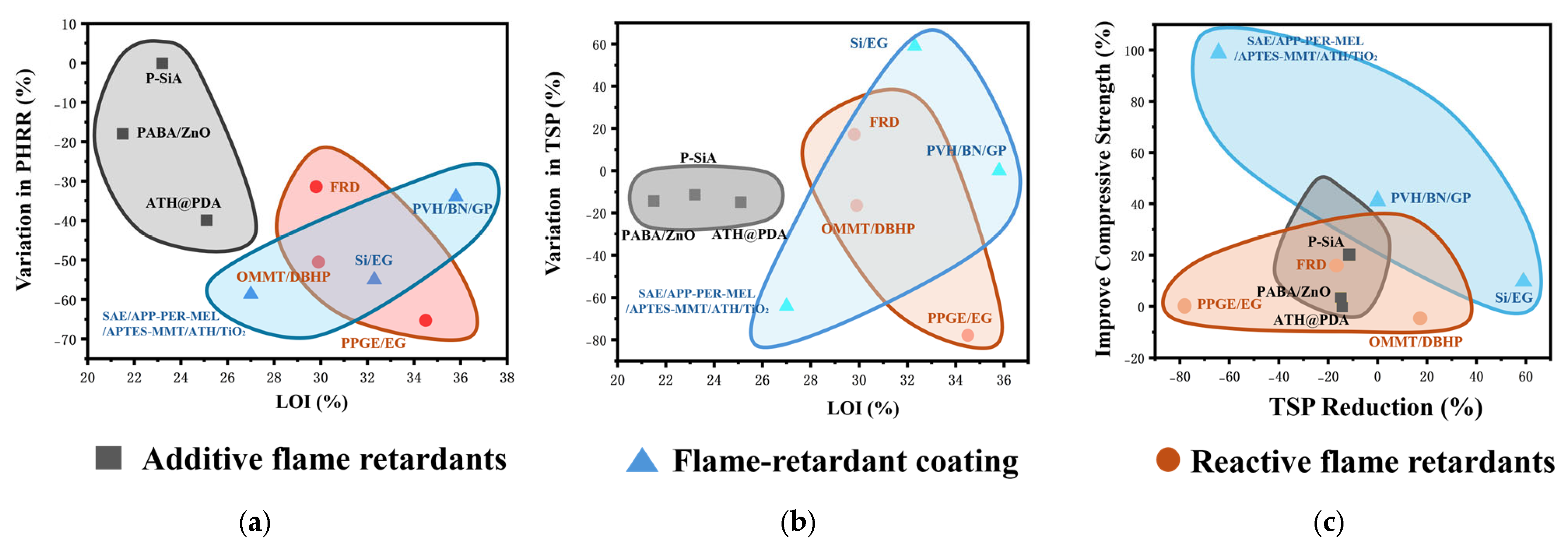
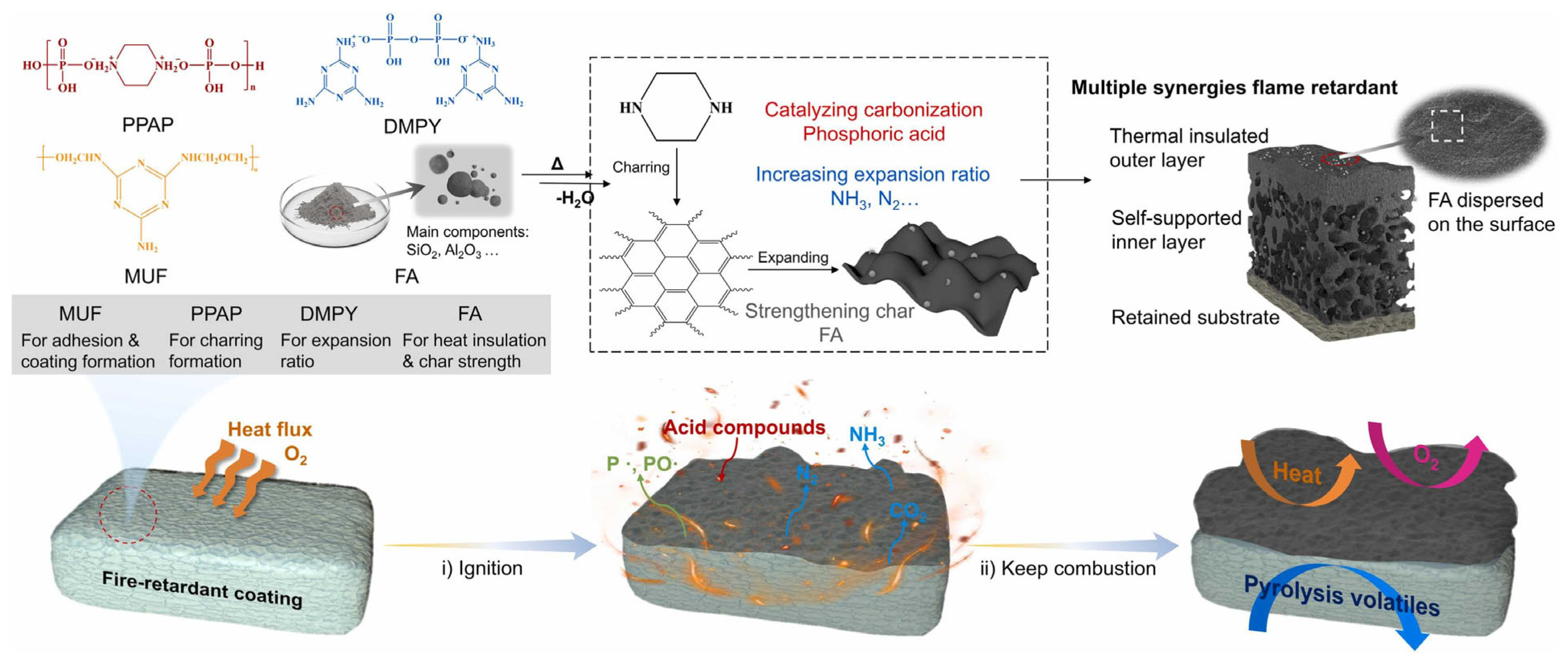
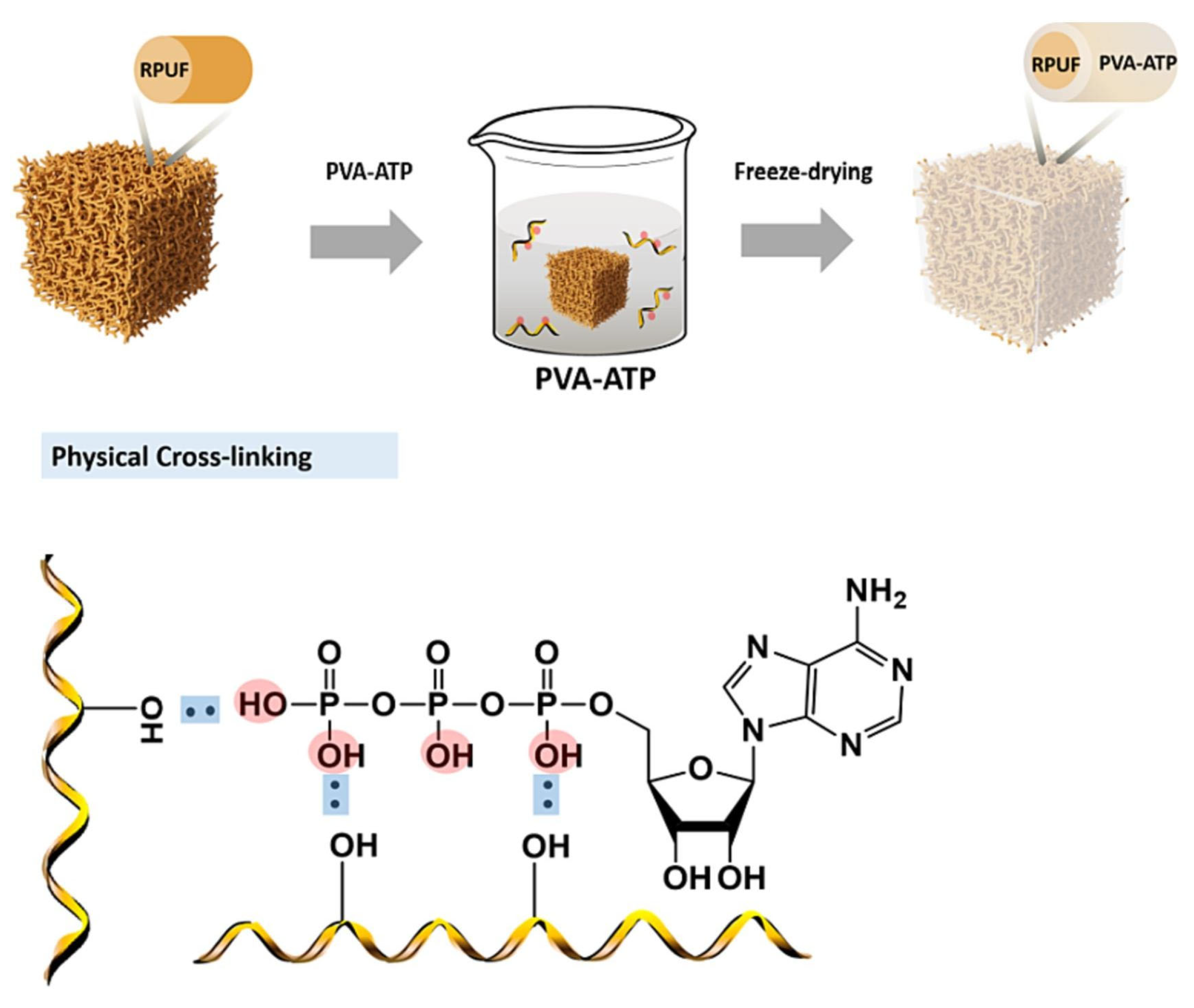
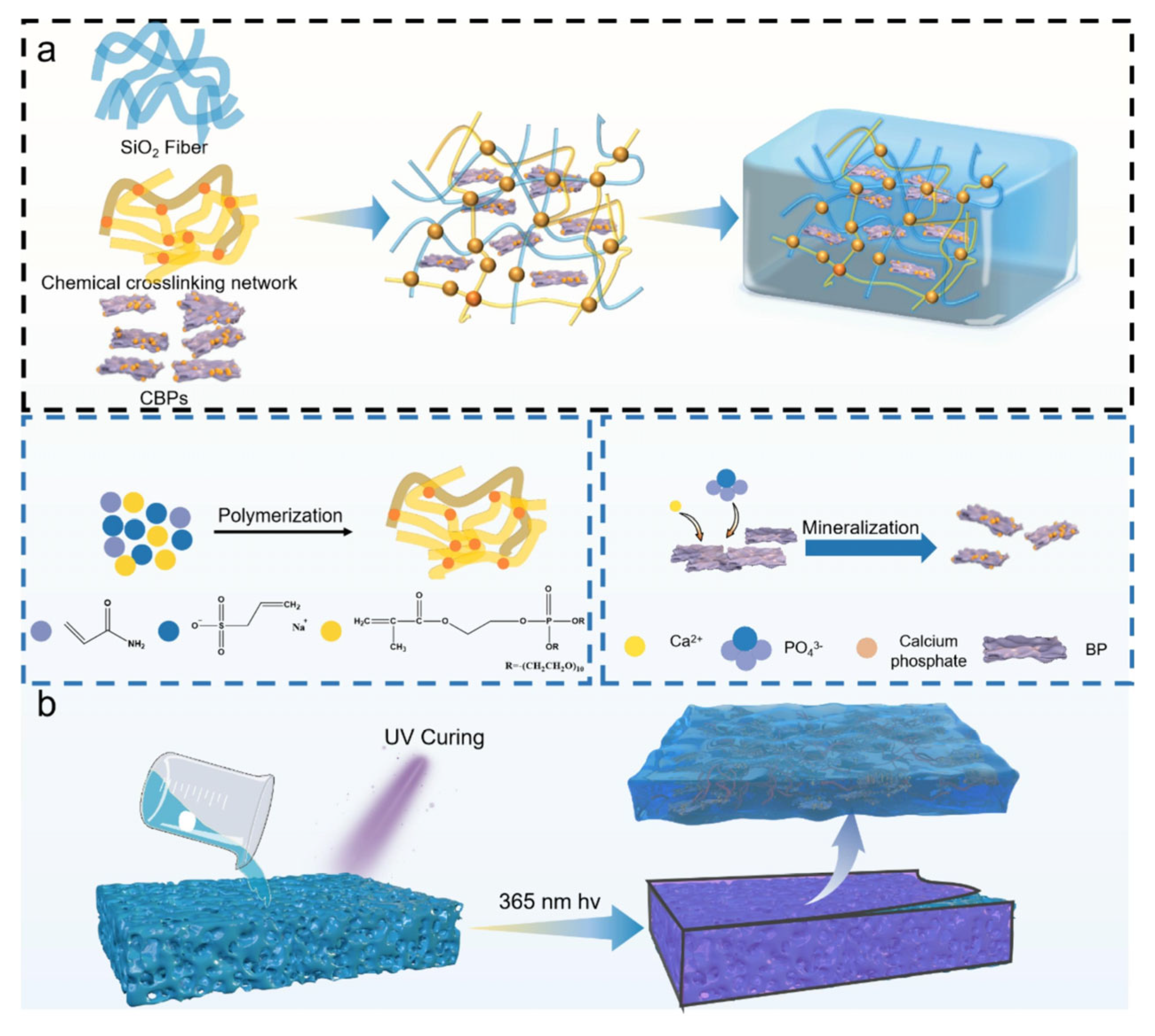
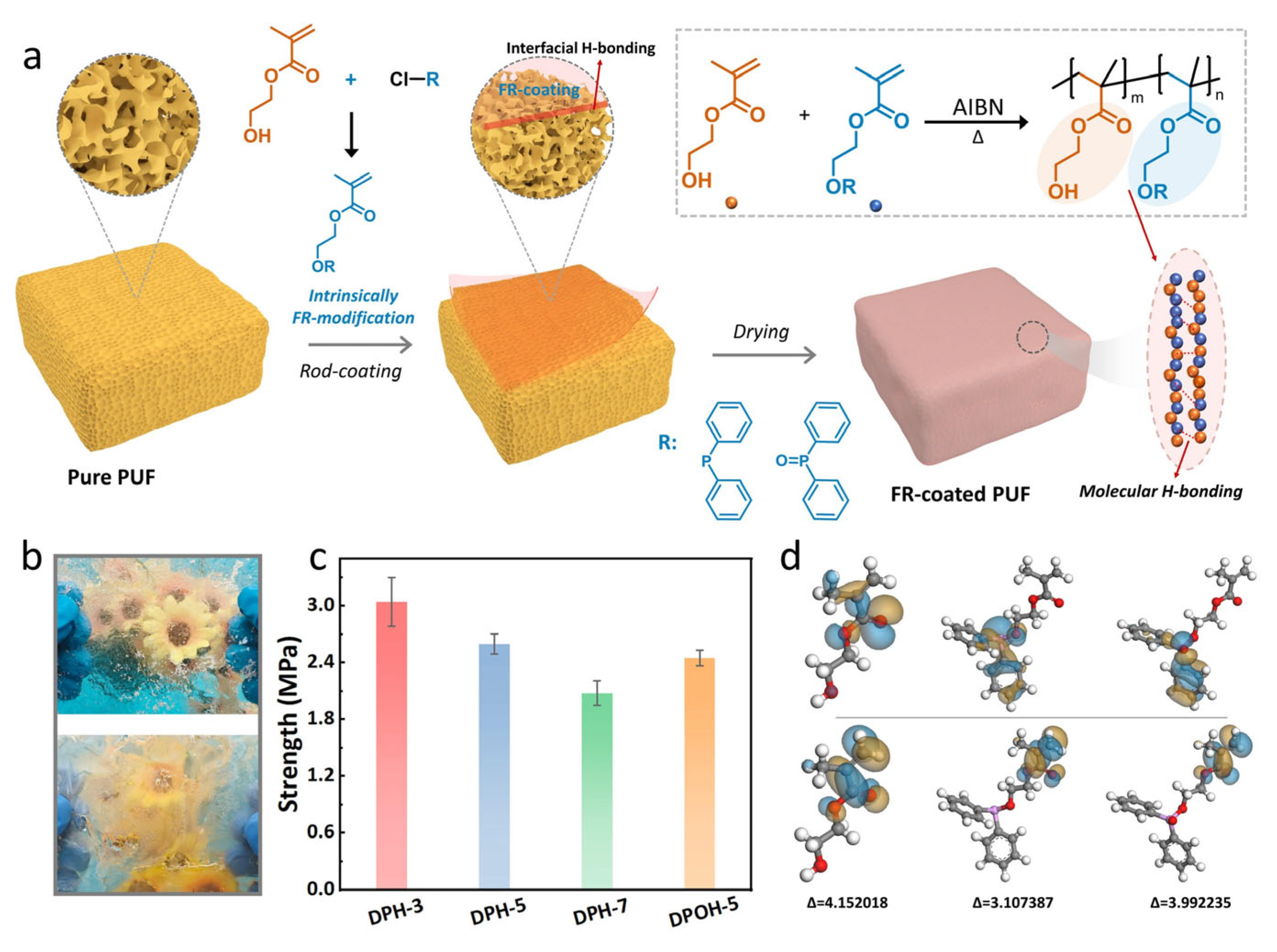
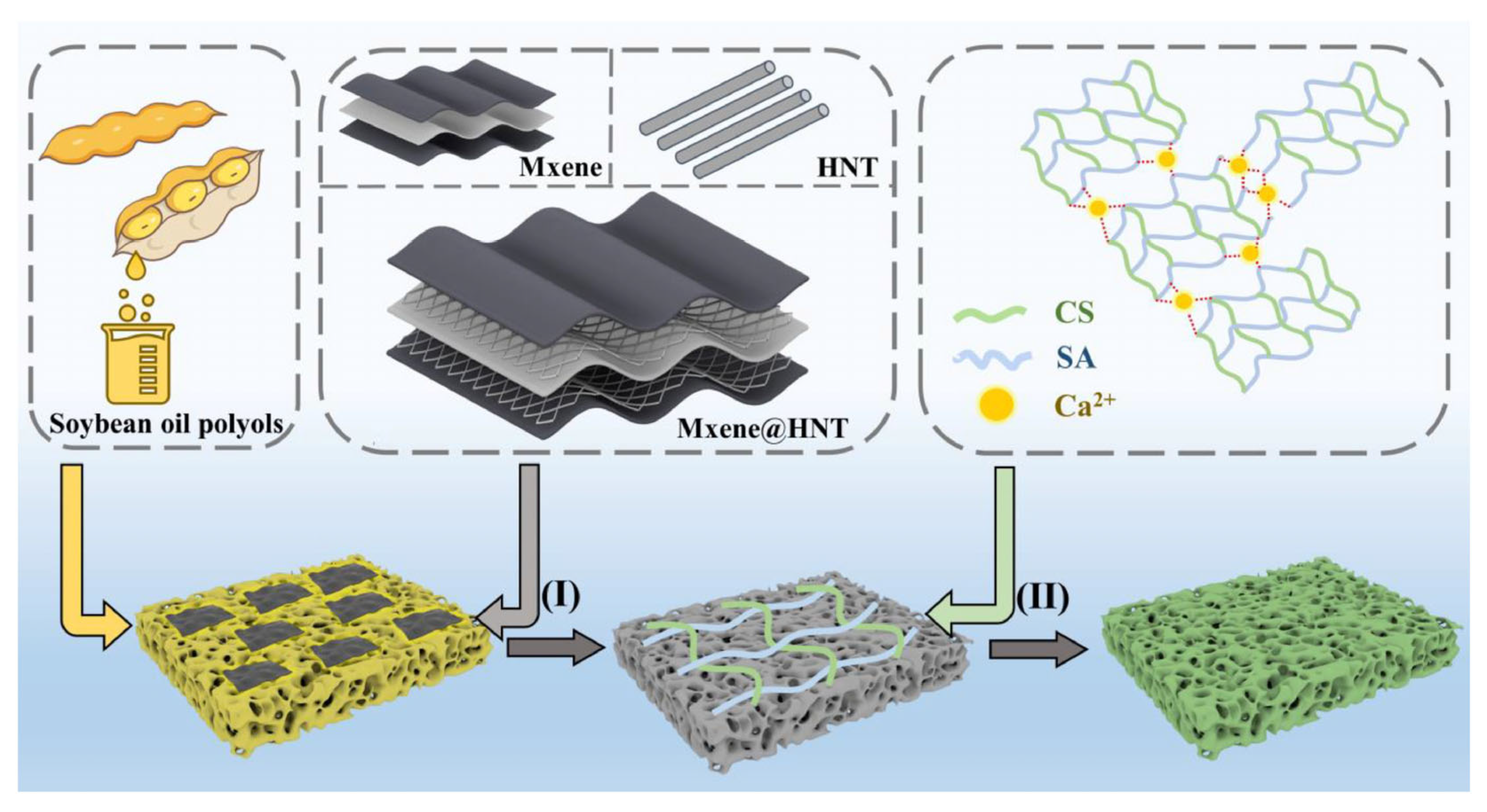
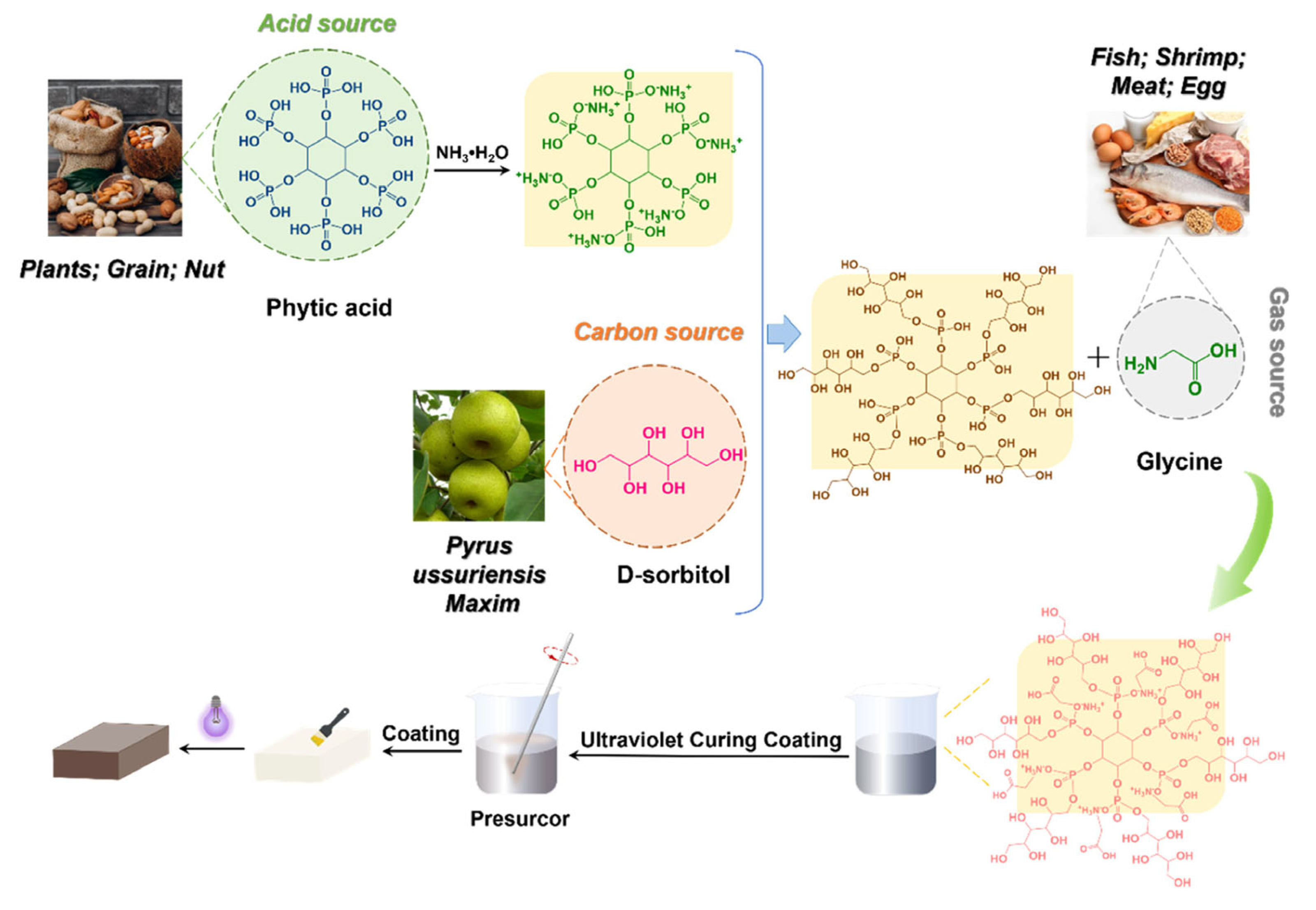
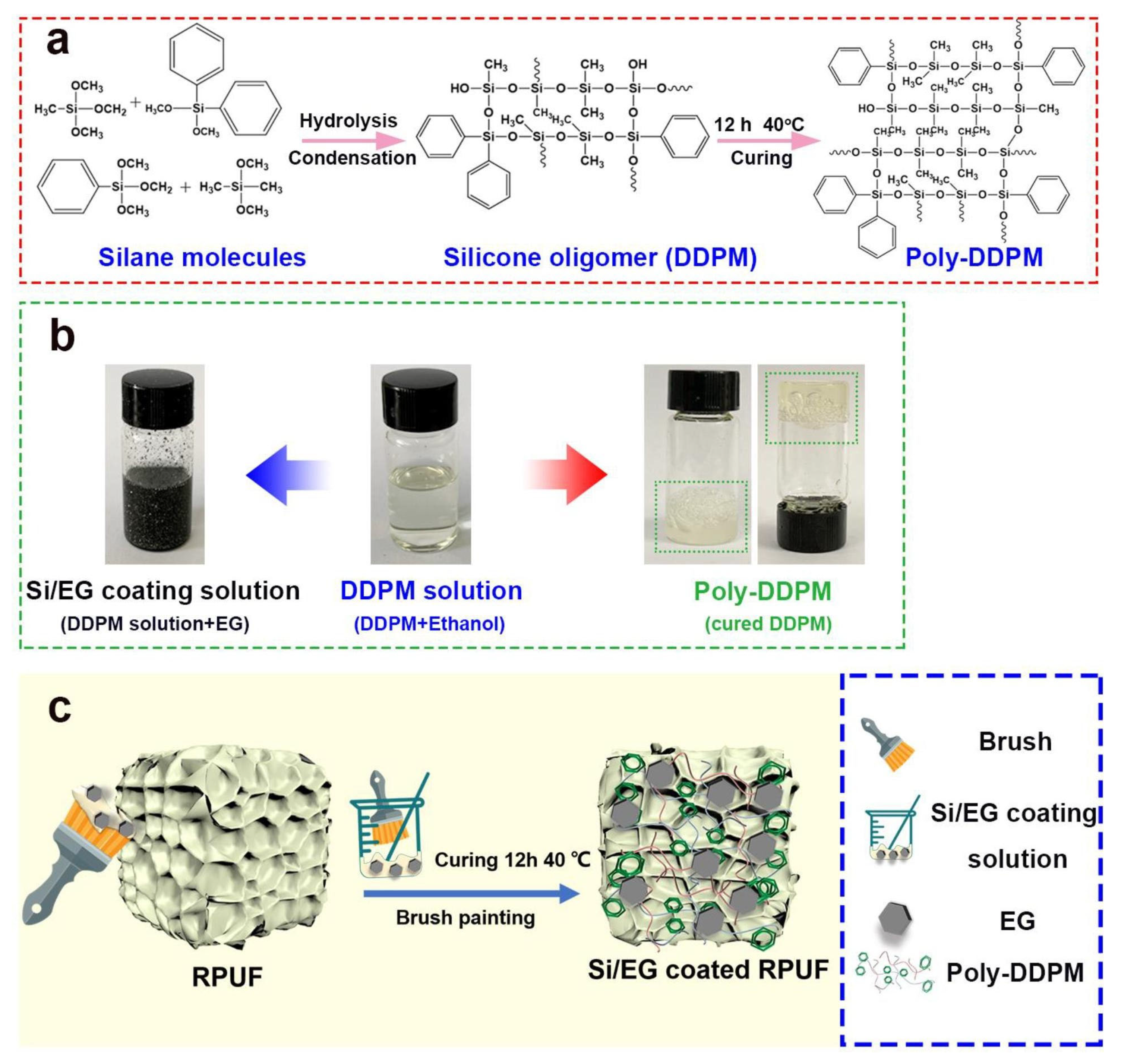
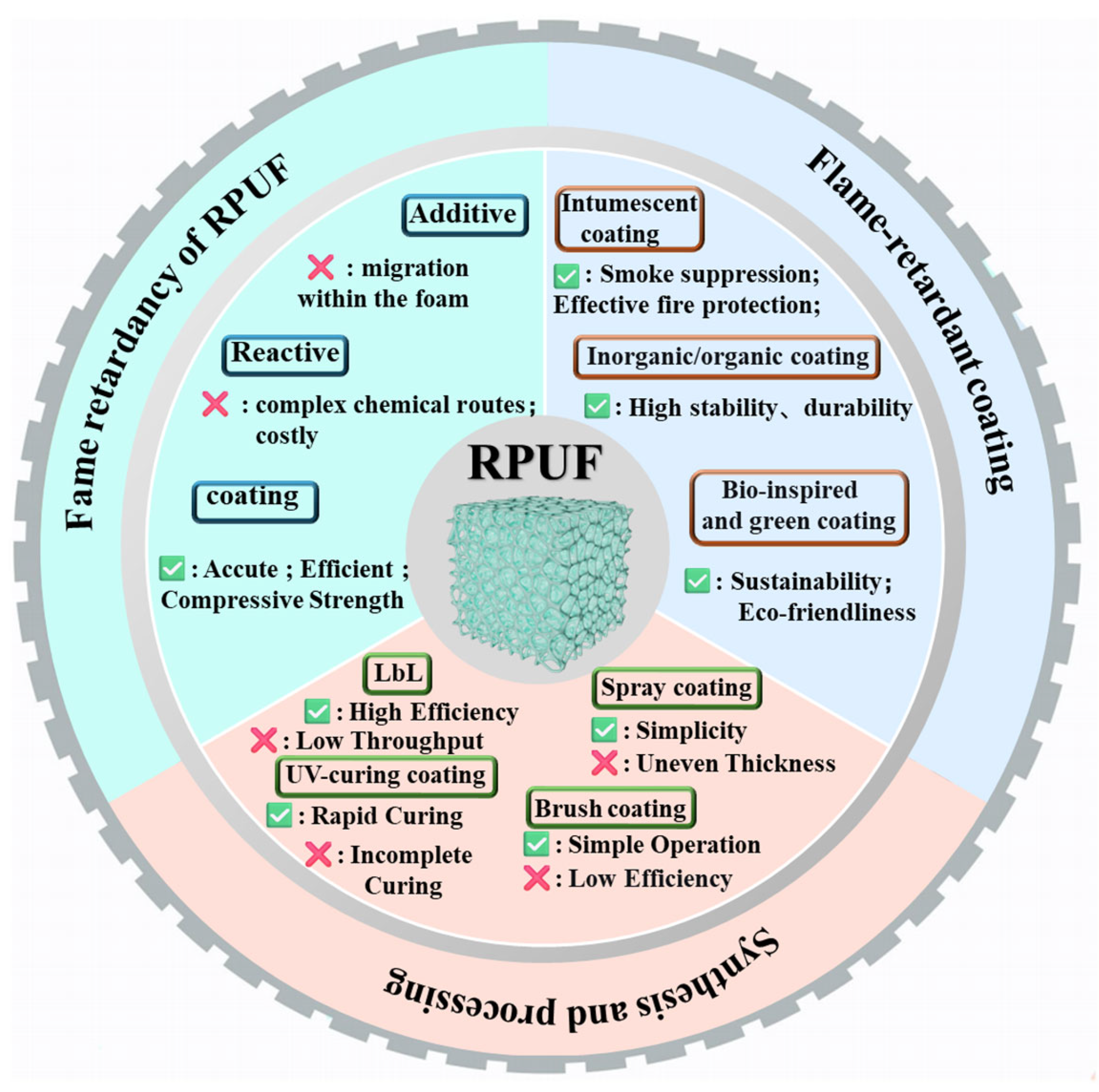
| Composition of Materials | Preparation Method | Fillers Content (wt%) | LOI (%) | PHRR (%) | THR (%) | TSP (%) | Char Yield (wt%) | Compressive Strength (%) | Ref. |
|---|---|---|---|---|---|---|---|---|---|
| P-SiA/RPUF | Additive | 15.0 | 23.2 | −0.1 | −36.3 | −11.4 | 30.1 | 20 | [67] |
| PABA/ZnO/RPUF | Additive | 15.0 | 21.5 | −17.95 | −24.1 | −14.38 | 30.4 | N/A | [68] |
| ATH@PDA/RPUF | Additive | 15.0 | 25.1 | −39.9 | −33.6 | −14.9 | 20.27 | 3.4 | [69] |
| OMMT/DBHP/RPUF | Reactive | 32.0 | 29.9 | −50.5 | −43.8 | −16.5 | 14.63 | 16 | [70] |
| FRD/RPUF | Reactive | 3.77 | 29.8 | −31.4 | −47.8 | 17.2 | 24.2 | −4.7 | [65] |
| PPGE/EG/RPUF | Reactive | 17.0 | 34.5 | −65.3 | −56.5 | −77.9 | 55.9 | N/A | [71] |
| Si/EG/RPUF | Coating | N/A | 32.3 | −55.0 | −21.7 | 59 | 38.6 | 10 | [72] |
| PVH/BN/GP/RPUF | Coating | N/A | 35.8 | −34 | −33 | N/A | 55.3 | 41 | [73] |
| SAE/APP-PER-MEL/APTES-MMT/ATH/TiO2/RPUF3 | Coating | 12.5 | 27 | −58.7 | −74.1 | −64.1 | 44.3 | 98.4 | [74] |
Disclaimer/Publisher’s Note: The statements, opinions and data contained in all publications are solely those of the individual author(s) and contributor(s) and not of MDPI and/or the editor(s). MDPI and/or the editor(s) disclaim responsibility for any injury to people or property resulting from any ideas, methods, instructions or products referred to in the content. |
© 2025 by the authors. Licensee MDPI, Basel, Switzerland. This article is an open access article distributed under the terms and conditions of the Creative Commons Attribution (CC BY) license (https://creativecommons.org/licenses/by/4.0/).
Share and Cite
Guo, Q.; Chen, J.; Xu, L.; Chen, M.; Zhang, Y.; Xiao, Y.; Yuan, Y.; Nguyen, K.; Wang, W. Advances in Flame-Retardant Coatings for Rigid Polyurethane Foams: A Critical Review. Fire 2025, 8, 419. https://doi.org/10.3390/fire8110419
Guo Q, Chen J, Xu L, Chen M, Zhang Y, Xiao Y, Yuan Y, Nguyen K, Wang W. Advances in Flame-Retardant Coatings for Rigid Polyurethane Foams: A Critical Review. Fire. 2025; 8(11):419. https://doi.org/10.3390/fire8110419
Chicago/Turabian StyleGuo, Qinhe, Jiong Chen, Lulu Xu, Min Chen, Yan Zhang, Yi Xiao, Yao Yuan, Kate Nguyen, and Wei Wang. 2025. "Advances in Flame-Retardant Coatings for Rigid Polyurethane Foams: A Critical Review" Fire 8, no. 11: 419. https://doi.org/10.3390/fire8110419
APA StyleGuo, Q., Chen, J., Xu, L., Chen, M., Zhang, Y., Xiao, Y., Yuan, Y., Nguyen, K., & Wang, W. (2025). Advances in Flame-Retardant Coatings for Rigid Polyurethane Foams: A Critical Review. Fire, 8(11), 419. https://doi.org/10.3390/fire8110419







